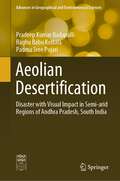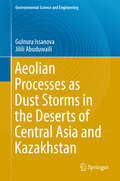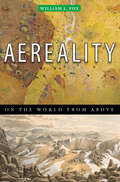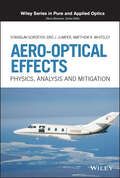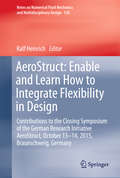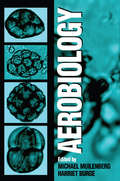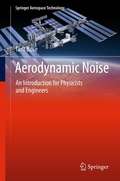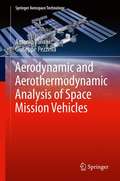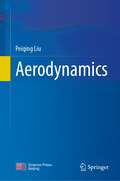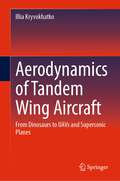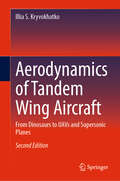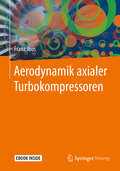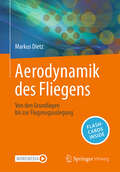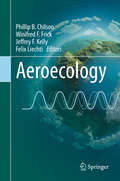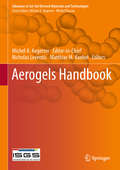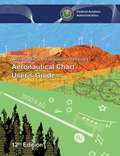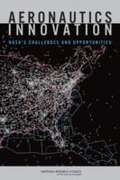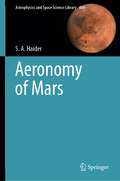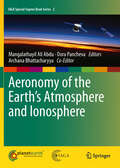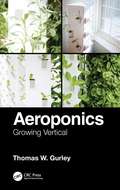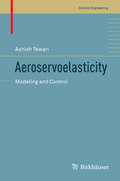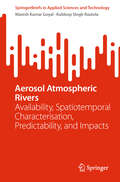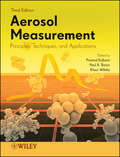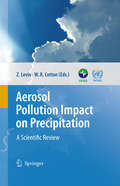- Table View
- List View
Aeolian Desertification: Disaster with Visual Impact in Semi-arid Regions of Andhra Pradesh, South India (Advances in Geographical and Environmental Sciences)
by Pradeep Kumar Badapalli Raghu Babu Kottala Padma Sree PujariThis book summarizes contemporary research on land degradation, desertification, and how such issues relate to socioeconomic growth in developing countries. With a focus on local and regional levels, the book offers an in-depth analysis of aeolian action as a physical process, causes of land degradation, and desertification. The causes and effects of land degradation were investigated by utilizing multiscale and multidisciplinary methodologies, merging spatial socioeconomic data with remote sensing data, and using multiple levels and disciplinary approaches. The book also describes how to combine GIS with cutting-edge technologies such as remote sensing, geostatistics, scanning electron microscopy (SEM) and energy-dispersive X-ray (EDAX) analysis, and analytical hierarchy approaches, among others. Included is a thorough case study of the unusual but understudied semi-arid Anantapur district in Andhra Pradesh, South India. This book encourages the participation of all socioeconomic groups in decision-making and assists authorities and planners in developing suitable plans for the sustainable agricultural growth of an area. The book is an invaluable resource to comprehend and resolve issues about sustainable environmental planning and management.
Aeolian proceses as Dust Storms in the Deserts of Central Asia and Kazakhstan (Environmental Science and Engineering)
by Gulnura Issanova Jilili AbuduwailiThis book highlights the aeolian processes in the desert zone of Kazakhstan and analyzes the current status of dust and sand storms in Central Asia and Kazakhstan. It also highlights the analyses, dynamics and long-term observations of storms on the basis of numerous cartographic materials and satellite images. Dust/sand storms are a common and important phenomenon in the arid and semi-arid regions of Kazakhstan, especially in its southern parts, where areas are covered by a great variety of deserts and offer a significant source of mineral and salt aerosols. The deserts of Kazakhstan mostly cover lowlands and extend from the eastern coast of the Caspian Sea to the piedmonts of the Tien-Shan Mountain. In Kazakhstan, desertification processes due to wind erosion in the form of dust/sand storms were observed in semi-desert and desert landscapes.
Aereality: On the World from Above
by William FoxWilliam Fox's writing for the last several years has been focused on how we construct aerial views, either physically (by flying) or in our imaginations.In Aereality, he flies over earthworks in Nevada and Utah, soars through the world's largest open pit mine, and surveys Los Angeles, circumnavigating large swaths of true American urban sprawl. On the East Coast, he examines the elevated art of the Hudson River Valley and New York City. And finally, in Australia, Fox examines the history and current practice of both Euro–Australian and Aboriginal aerial views, and searches for the cognitive roots of our aerial imagination.Accompanying Fox throughout his travels is a rolling cast of enlightened fliers: geographers, museum curators, landscape photographers, anthropologists, and artists. He traverses the sky in prop planes, helicopters, and hot air balloons, all with the ultimate goal of knowing and experiencing the earth from the air.
Aero-Optical Effects: Physics, Analysis and Mitigation (Wiley Series in Pure and Applied Optics)
by Stanislav Gordeyev Eric J. Jumper Matthew R. WhiteleyAERO-OPTICAL EFFECTS Explore the newest techniques and technologies used to mitigate the effects of air flow over airborne laser platforms Aero-Optical Effects: Physics, Analysis and Mitigation delivers a detailed and insightful introduction to aero-optics and fully describes the current understanding of the physical causes of aero-optical effects from turbulent flows at different speeds. In addition to presenting a thorough discussion of instrumentation, data reduction, and data analysis, the authors examine various approaches to aero-optical effect mitigation using both flow control and adaptive optics approaches. The book explores the sources, characteristics, measurement approaches, and mitigation means to reduce aero-optics wavefront error. It also examines the precise measurements of aero-optical effects and the instrumentation of aero-optics. Flow control for aero-optical applications is discussed, as are approaches like passive flow control, active and hybrid flow control, and closed-loop flow control. Readers will benefit from discussions of the applications of aero-optics in relation to fields like directed energy and high-speed communications. Readers will also enjoy a wide variety of useful features and topics, including: Comprehensive discussions of both aero-effects, which include the effects that air flow has over a beam director mounted on an aircraft, and aero-optics, which include atmospheric effects that degrade the ability of an airborne laser to focus a beam A treatment of air buffeting and its effects on beam stabilization and jitter An analysis of mitigating impediments to the use of high-quality laser beams from aircraft as weapons or communications systems Adaptive optics compensation for aero-optical disturbances Perfect for researchers, engineers, and scientists involved with laser weapon and beam control systems, Aero-Optical Effects: Physics, Analysis and Mitigation will also earn a place in the libraries of principal investigators in defense contract work and independent research and development.
AeroStruct: Contributions to the Closing Symposium of the German Research Initiative AeroStruct, October 13–14, 2015, Braunschweig, Germany (Notes on Numerical Fluid Mechanics and Multidisciplinary Design #138)
by Ralf HeinrichThis book reports on the German research initiative AeroStruct, a three-year collaborative project between universities and the aircraft industry. It describes the development of an integrated multidisciplinary simulation environment for aircraft analysis and optimization using high-fidelity methods. This system is able to run at a high level of automatism, thus representing a step forward with respect to previous ones. Its special features are: a CAD description that is independent from the disciplines involved, an automated CFD mesh generation and an automated structure model generation including a sizing process. The book also reports on test cases by both industrial partners and DLR demonstrating the advantages of the new environment and its suitability for the industry. These results were also discussed during the AeroStruct closing Symposium, which took place on 13-14 October 2015 at the DLR in Braunschweig, Germany. The book provides expert readers with a timely report on multidisciplinary aircraft design and optimization. Thanks to a good balance between theory and practice, it is expected to address an audience of both academics and professional, and to offer them new ideas for future research and development.
Aerobiology
by Michael L. Muilenberg Harriet A. BurgeAerobiology is the study of airborne particles that have an impact on humans and other organisms. Every day, we are exposed to airborne particles, including "natural" particles such as pollen, bacteria, and fungi, and "unnatural" particles, such as asbestos fibers and noxious chemicals. Aerobiology highlights the current interests in this field, primarily the ecology and distribution of airborne particles and their effects on health.
Aerodynamic Noise: An Introduction for Physicists and Engineers (Springer Aerospace Technology #7)
by Tarit BoseAerodynamic Noise extensively covers the theoretical basis and mathematical modeling of sound, especially the undesirable sounds produced by aircraft. This noise could come from an aircraft's engine--propellers, fans, combustion chamber, jets--or the vehicle itself--external surfaces--or from sonic booms. The majority of the sound produced is due to the motion of air and its interaction with solid boundaries, and this is the main discussion of the book. With problem sets at the end of each chapter, Aerodynamic Noise is ideal for graduate students of mechanical and aerospace engineering. It may also be useful for designers of cars, trains, and wind turbines.
Aerodynamic and Aerothermodynamic Analysis of Space Mission Vehicles
by Antonio Viviani Giuseppe PezzellaPresenting an up-to-date view on the most important space vehicle configurations, this book contains detailed analyses for several different type of space mission profiles while considering important factors such as aerodynamic loads, aerodynamic heating, vehicle stability and landing characteristics. With that in mind, the authors provide a detailed overview on different state-of-the-art themes of hypersonic aerodynamics and aerothermodynamics, and consider different space vehicle shapes useful for different space mission objectives. These include: #65533; Crew Return Vehicle (CRV) #65533; Crew Exploration Vehicle (CEV) #65533; Sample Return Vehicle (SRV) #65533; Flying Test Bed (FTB). Throughout Aerodynamic and Aerothermodynamic Analysis of Space Mission Vehicles many examples are given, with detailed computations and results for the aerodynamics and aerothermodynamics of all such configurations. Moreover, a final chapter on future launchers is provided and an Appendix on a possible manned mission to Mars closes the book. This work can be used as a reference for modelling and design techniques, for students intending to enter aerospace industrial careers, and to support both academics and engineers working in the field of space vehicle design. This book has been awarded the Basic Science Book award 2016 by the International Academy of Astronautics (IAA), presented during the 67th International Astronautical Congress (IAC2016) held in September 2016 in Guadalajara, Mexico.
Aerodynamics
by Peiqing LiuThis textbook highlights the fundamentals of aerodynamics and the applications in aeronautics. The textbook is divided into two parts: basic aerodynamics and applied aerodynamics. The first part focuses on the basic principles and methods of aerodynamics. The second part covers the aerodynamic characteristics of aircraft in low speed, subsonic, transonic and supersonic flows. The combination of the two parts aims to cultivate students' aerospace awareness, build the ability to raise and solve problems and the ability to make comprehensive use of the knowledge to carry out innovative practice. This book is intended for undergraduates majoring in aircraft design and engineering, engineering mechanics, flight mechanics, missile design, etc. It can also be used as a reference for postgraduates, researchers and engineers of aerospace related majors.
Aerodynamics of Tandem Wing Aircraft: From Dinosaurs to UAVs and Supersonic Planes
by Illia KryvokhatkoThis book contains extensive data about tandem wing aircraft. It includes a review of modern flying vehicles with four fixed wings, a review of analytical, numerical and experimental methods; results of the studies about aerodynamics; dependencies between geometrical parameters and aerodynamic characteristics, practical recommendations in development and optimizing of tandem wing aircraft to provide high lift-to-drag ratio, stability, and controllability. This is an ideal book for graduate students, researchers, and engineers working in fields of aerodynamics and conceptual design of the aircraft especially UAVs, ground-effect vehicles, and convertiplanes.
Aerodynamics of Tandem Wing Aircraft: From Dinosaurs to UAVs and Supersonic Planes
by Illia S. KryvokhatkoThis updated, second edition adds more reviews of modern four-winged aircraft belonging to convertiplanes, Medium Altitude Long Endurance UAVs, and solar planes. As in the first edition, different analytical, numerical, and experimental methods are discussed in detail. The book presents new sections on unsteady aerodynamic characteristics of tandem wings and specifics of their aerodynamic loading for stress analysis and structural design. Also, dependencies between key geometric parameters and aerodynamic characteristics were updated with new studies that helped to understand the physics more deeply and even reinterpret previous experimental results. Accordingly, practical recommendations in development and optimizing of tandem wing aircraft were updated to provide high endurance, wide range of flight velocities, stability, and controllability. This is an ideal book for graduate students, researchers, and engineers working in fields of aerodynamics and conceptual design of the aircraft especially UAVs and light piloted airplanes.
Aerodynamik axialer Turbokompressoren
by Franz JoosDieses Fachbuch gibt einen fundierten Einblick in die mehrdimensionale Aerodynamik von Turbokompressoren anhand aktueller Designmerkmale sowie deren physikalischer Grundlagen. Zur Effizienzsteigerung von Gasturbinen und Industriekompressoren werden die Beschaufelungen mehrdimensional ausgelegt.
Aerodynamik des Fliegens: Von den Grundlagen bis zur Flugzeugauslegung
by Markus DietzSie interessieren sich für die Aerodynamik von Flugzeugen, und Ihr Interesse geht über die populärwissenschaftliche Darstellung hinaus? Gleichungen schrecken Sie nicht ab, denn Sie verfügen über mathematische und physikalische Kenntnisse aus einem technischen Studium? Dann bietet Ihnen dieses Lehrbuch einen umfassenden Überblick über die Flugzeugaerodynamik von den strömungsmechanischen und aerodynamischen Grundlagen bis hin zur Flugzeugauslegung. Das Werk erfordert über ein mathematisch-physikalisches Grundwissen hinaus keine Vorkenntnisse. Nach dem Studium des Buches verfügen Sie über ein solides Wissen zur Aerodynamik von Profilen und Tragflügeln und verstehen die unterschiedliche aerodynamische Auslegung verschiedener Flugzeugtypen wie Segelflugzeuge, Kleinflugzeuge, Verkehrsflugzeuge und überschallschnelle Kampfflugzeuge.Weil das Werk auch auf die Grundlagen der Flugmechanik und Flugleistungsrechnung eingeht, eignet es sich auch als Begleitwerk für ein Luftfahrttechnik-Studium, um einerseits den Blick „aufs Wesentliche“ nicht zu verlieren und zum anderen, um die Verknüpfungen zwischen den Disziplinen Strömungsmechanik, Aerodynamik, Flugmechanik und Flugzeugauslegung besser zu verstehen. Auch auf fliegerische Aspekte wird an vielen Stellen eingegangen, beispielsweise auf den Zusammenhang zwischen der aerodynamischen Gestaltung des Flugzeugs und seinen Flugeigenschaften, den Aufbau der Atmosphäre und die Definition der „Airspeeds“ und deren Umrechnung. Damit stellt das Buch auch für Berufs- und Hobbypiloten eine sinnvolle Ergänzung dar. Abgerundet wird das Werk durch einige Informationen zu den relevanten historischen Persönlichkeiten und Meilensteinen der Luftfahrt.Am Ende der meisten Kapitel befinden sich Übungsaufgaben, die so gestalten wurden, dass das Erlernte vertieft wird. Eine kurze Zusammenfassung des nötigen mathematischen und thermodynamischen Handwerkszeugs findet sich im Anhang des Buchs.Zusätzliche Fragen per App: Zur Überprüfung des Lernerfolgs stehen insgesamt 170 Flashcards-Fragen bereit. Laden Sie die Springer-Nature-Flashcards-App kostenlos herunter und nutzen Sie exklusives Zusatzmaterial, um Ihr Wissen zu prüfen.
Aeroecology
by Phillip B. Chilson Winifred F. Frick Jeffrey F. Kelly Felix LiechtiThis book consists of a diverse collection of chapters that seeks to broaden our fundamental understanding of the ecological function and biological importance of the Earth’s lower atmosphere, which provides a huge living space for billions of animals moving within and across continents. <P><P>Their migration, dispersal and foraging activities connect water and land habitats within and across continents. Drawing upon the wide-ranging experience of the authors, the book takes an inherently interdisciplinary approach that serves to introduce the reader to the topic of aeroecology, frame some of the basic biological questions that can be addressed within the context of aeroecology, and highlight several existing and emerging technologies that are being used to promote aeroecological studies. The book begins with several background chapters, that provide introduction into such topics as atmospheric science, the concept of the habitat, animal physiology, and methods of navigation. It then continues with a broad discussion of observational methods available to and used by aeroecologists. Finally, several targeted examples of aeroecological studies are presented. <P><P>Following the development of the chapters, the reader is provided with a unifying framework for investigating how the dynamic properties of meteorological conditions at local, regional, and global scales affect the organisms that depend on the air for foraging and movement. Material presented in the book should be of interest to anyone wishing to gain a comprehensive understanding of the aerosphere itself and the myriad airborne organisms that inhabit and depend upon this environment for their existence. The material should be accessible to a diverse set of readers at all stages of training and across a range of research expertise.
Aerogels Handbook (Advances in Sol-Gel Derived Materials and Technologies)
by Michel Andre Aegerter Matthias M. Koebel Nicholas LeventisAerogels are the lightest solids known. Up to 1000 times lighter than glass and with a density as low as only four times that of air, they show very high thermal, electrical and acoustic insulation values and hold many entries in Guinness World Records. Originally based on silica, R&D efforts have extended this class of materials to non-silicate inorganic oxides, natural and synthetic organic polymers, carbon, metal and ceramic materials, etc. Composite systems involving polymer-crosslinked aerogels and interpenetrating hybrid networks have been developed and exhibit remarkable mechanical strength and flexibility. Even more exotic aerogels based on clays, chalcogenides, phosphides, quantum dots, and biopolymers such as chitosan are opening new applications for the construction, transportation, energy, defense and healthcare industries. Applications in electronics, chemistry, mechanics, engineering, energy production and storage, sensors, medicine, nanotechnology, military and aerospace, oil and gas recovery, thermal insulation and household uses are being developed with an estimated annual market growth rate of around 70% until 2015. The Aerogels Handbook summarizes state-of-the-art developments and processing of inorganic, organic, and composite aerogels, including the most important methods of synthesis, characterization as well as their typical applications and their possible market impact. Readers will find an exhaustive overview of all aerogel materials known today, their fabrication, upscaling aspects, physical and chemical properties, and most recent advances towards applications and commercial products, some of which are commercially available today. Key Features: *Edited and written by recognized worldwide leaders in the field *Appeals to a broad audience of materials scientists, chemists, and engineers in academic research and industrial R&D *Covers inorganic, organic, and composite aerogels *Describes military, aerospace, building industry, household, environmental, energy, and biomedical applications among others
Aeronautical Chart User's Guide: Aeronav Products (FAA Handbooks Ser.)
by Federal Aviation AdministrationThe updated 11th edition of the Aeronautical Chart User’s Guide by the FAA is a great reference for novice pilots and professionals alike. Printed in full color with detailed examples, this book provides all the information students and pilots need to know about all the symbols and information provided on US aeronautical charts and chart navigation publications. Readers will find information on VFR charts, aeronautical chart symbols, helicopter route charts, flyway planning charts, IFR enroute charts, explanation of IFR enroute terms and symbols, Terminal Procedure Publications (TPPs), explanation of TPP terms and symbols, airspace classifications, and an airspace class table.
Aeronautics Innovation: Nasa's Challenges And Opportunities
by National Research Council of the National AcademiesNASA is a global leader in aeronautics research and development — fostering advances in aviation safety and emissions, propulsion technology, and many other areas. And the agency's Aeronautics Research Mission Directorate (ARMD) has played a vital role in the U.S. aeronautics industry. In recent years, the directorate's leaders and experts outside the agency have sought ways to speed innovative uses of ARMD's research results. But the directorate faces management challenges that make it difficult for such applications to succeed — or to occur at all. This report from the National Academies' National Research Council, offers the agency guidance on how to manage the transfer of technology to external users, as well as implement flexible personnel and financial-management practices. The report also points out problems that stem from a lack of agreement on ARMD's future direction and several years of federal budget cuts.
Aeronomy of Mars (Astrophysics and Space Science Library #469)
by S. A. Haider“Mangalyaan was launched on November 5, 2013, to Mars by Indian Space Research Organization (ISRO). On October 2, 2022, ISRO declared that Mangalyaan had lost communications with Earth. Mars Color Camera (MCC) on-board Mangalyaan has taken thousands pictures of Mars. A full disk of Mars image observed by Viking is shown on the cover page of this book. Mars is covered by the dust as observed by Mangalyaan (from Arya et al., 2015). This book presents the atmospheric and ionospheric results obtained from all missions to Mars. It also covers various atmospheric and ionospheric models of Mars. Broadly speaking, the planet’s atmosphere can be divided into two regions: lower and upper. These two regions can be coupled due to the propagation of energy from the lower to the upper atmosphere. The first-ever book on the aeronomy of Mars, this work is intended to help students and researchers familiarize themselves with the field of aeronomy. In addition, it helps planetary probe designers, engineers, and other users in the scientific community, e.g., planetary geologists and geophysicists”.
Aeronomy of the Earth's Atmosphere and Ionosphere (IAGA Special Sopron Book Series #2)
by Archana Bhattacharyya Dora Pancheva Mangalathayil Ali AbduThis book is a multi-author treatise on the most outstanding research problems in the field of the aeronomy of the Earth's atmosphere and ionosphere, encompassing the science covered by Division II of the International Association of Geomagnetism and Aeronomy (IAGA). It contains several review articles and detailed papers by leading scientists in the field. The book is organized in five parts: 1) Mesosphere-Lower Thermosphere Dynamics and Chemistry; 2) Vertical Coupling by Upward Propagating Waves; 3) Ionospheric Electrodynamics and Structuring; 4) Thermosphere- Ionosphere Coupling, Dynamics and Trends and 5) Ionosphere-Thermosphere Disturbances and Modeling. The book consolidates the progress achieved in the field in recent years and it serves as a useful reference for graduate students as well as experienced researchers.
Aeroponics: Growing Vertical
by Thomas W. GurleyAeroponics: Growing Vertical covers aspects of the emerging technology, aeroponics, which is a sister to hydroponics, involving state-of-the-art controlled environment agriculture. The book begins with an introduction of aeroponics followed by a summary of peer-reviewed technical literature conducted over 50 years involving various aspects of aeroponics. It covers the science and all the patent literature since 2001 to give the reader a comprehensive view of the innovations related to aeroponics. This book is a useful reference for people interested in learning about how aeroponics works. This book is for novices as well as scientists interested in research activities conducted in countries around the world as well as work in using aeroponics in outer space. Designed for the user interested in research conducted in the past, this a helpful resource for those in the next generation of profitable agricultural endeavors. Features: · Comprehensive resource presenting key aspects of aeroponics · Focus on areas of aeroponics including its history, science, innovations, business, and practice · Provides a complete overview of the intellectual property associated with aeroponics · Presents a broad overview of research using aeroponic systems across the globe · Features information on key start-up businesses and activities that drive this technology Thomas Gurley earned a BA in chemistry from Houghton College and a PhD in analytical chemistry from Case Western Reserve University and has 40 years industrial chemistry experience with companies including Goodyear, Abbott Labs, and his consulting company, Manning Wood LLC. He holds two Fulbright scholarships to Ukraine and Uganda. He is currently R&D Director for Aero Development Corporation, a manufacturer of aeroponic commercial growing systems. He conducts research in aeroponics as an adjunct professor at Charleston Southern University in South Carolina.
Aeroservoelasticity: Modeling and Control (Control Engineering)
by Ashish TewariThis monograph presents the state of the art in aeroservoelastic (ASE) modeling and analysis and develops a systematic theoretical and computational framework for use by researchers and practicing engineers. It is the first book to focus on the mathematical modeling of structural dynamics, unsteady aerodynamics, and control systems to evolve a generic procedure to be applied for ASE synthesis. Existing robust, nonlinear, and adaptive control methodology is applied and extended to some interesting ASE problems, such as transonic flutter and buffet, post-stall buffet and maneuvers, and flapping flexible wing. The author derives a general aeroservoelastic plant via the finite-element structural dynamic model, unsteady aerodynamic models for various regimes in the frequency domain, and the associated state-space model by rational function approximations. For more advanced models, the full-potential, Euler, and Navier-Stokes methods for treating transonic and separated flows are also briefly addressed. Essential ASE controller design and analysis techniques are introduced to the reader, and an introduction to robust control-law design methods of LQG/LTR and H2/H∞ synthesis is followed by a brief coverage of nonlinear control techniques of describing functions and Lyapunov functions. Practical and realistic aeroservoelastic application examples derived from actual experiments are included throughout. Aeroservoelasiticity fills an important gap in the aerospace engineering literature and will be a valuable guide for graduate students and advanced researchers in aerospace engineering, as well as professional engineers, technicians, and test pilots in the aircraft industry and laboratories.
Aerosol Atmospheric Rivers: Availability, Spatiotemporal Characterisation, Predictability, and Impacts (SpringerBriefs in Applied Sciences and Technology)
by Manish Kumar Goyal Kuldeep Singh RautelaThis book thoroughly examines aerosol pollution and aerosol atmospheric rivers (narrow corridors of concentrated suspended aerosols in the sky), exploring their significant effects on human health, the environment, and global climate. Readers will find detailed discussions on these phenomena' sources, composition, patterns, and advanced methods for their detection, monitoring, and mitigation. Each chapter examines the complex dynamics of aerosol atmospheric rivers and the use of data mining and artificial intelligence in analyzing aerosol pollution. The book also highlights the interactions between aerosol pollution, aerosol atmospheric rivers, and particulate matter concentrations with associated risk, offering practical adaptation, mitigation, and resilience strategies.
Aerosol Measurement
by Klaus Willeke Paul A. Baron Pramod KulkarniAerosol Measurement: Principles, Techniques, and Applications Third Edition is the most detailed treatment available of the latest aerosol measurement methods. Drawing on the know-how of numerous expert contributors; it provides a solid grasp of measurement fundamentals and practices a wide variety of aerosol applications.This new edition is updated to address new and developing applications of aerosol measurement, including applications in environmental health, atmospheric science, climate change, air pollution, public health, nanotechnology, particle and powder technology, pharmaceutical research and development, clean room technology (integrated circuit manufacture), and nuclear waste management.
Aerosol Optical Depth and Precipitation: Measuring Particle Concentration, Health Risks and Environmental Impacts
by Sneha Gautam Cyril Samuel Roshini Praveen KumarThis volume uses aerosol optical depth (AOD) analysis through mapping and remote sensing techniques to derive the relationship between aerosols and hazardous precipitation events, primarily in the form of flooding. Attention is also given to pollution caused by an abundance of particulate matter in the atmosphere and its impacts on human health, which is also assessed via the study of AOD. Background is given on how AOD is retrieved, and why it is a useful tool for estimating atmospheric particle concentration, but also the challenges associated with using this approach. Different aerosol types are introduced to perform a comparative analysis of the most common associations between pollution impacts on temperature and resulting precipitation events. These analyses will help to provide an overview of the best strategies to make informed and sustainable disaster risk management practices and policies. The target audience for the work is students, researchers, and scientists working witha vision towards sustainability, public health safety and air pollution mitigation measures. It will also be a useful text for climate change policy makers, environmental engineers and stakeholders in social development sectors.
Aerosol Pollution Impact on Precipitation: A Scientific Review
by Zev Levin William R. CottonLife on Earth is critically dependent upon the continuous cycling of water between oceans, continents and the atmosphere. Precipitation (including rain, snow, and hail) is the primary mechanism for transporting water from the atmosphere back to the Earth's surface. It is also the key physical process that links aspects of climate, weather, and the global hydrological cycle. Changes in precipitation regimes and the frequency of extreme weather events, such as floods, droughts, severe ice/snow storms, monsoon fluctuations and hurricanes are of great potential importance to life on the planet. One of the factors that could contribute to precipitation modification is aerosol pollution from various sources such as urban air pollution and biomass burning. Natural and anthropogenic changes in atmospheric aerosols might have important implications for precipitation by influencing the hydrological cycle, which in turn could feed back to climate changes. From an Earth Science perspective, a key question is how changes expected in climate will translate into changes in the hydrological cycle, and what trends may be expected in the future. We require a much better understanding and hence predictive capability of the moisture and energy storages and exchanges among the Earth's atmosphere, oceans, continents and biological systems. This book is a review of our knowledge of the relationship between aerosols and precipitation reaching the Earth's surface and it includes a list of recommendations that could help to advance our knowledge in this area.
